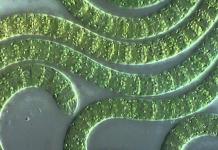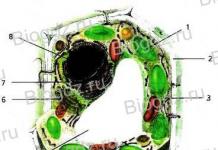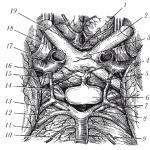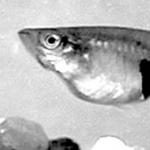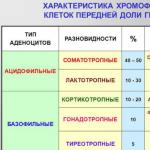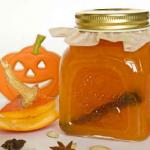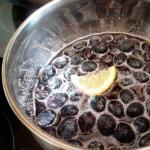Therefore, the fight against malaria is carried out along two lines:
- by treating patients with malaria, who can be a source of infection for others if Anopheles mosquitoes are found in the area, and
- by controlling mosquitoes that may be carriers and transmitters of malaria.
The development of mosquitoes occurs in stagnant water - in ponds, lakes and swamps; Therefore, there are especially many mosquitoes in damp and swampy areas, and therefore, in such areas, malaria - “swamp fever” - is especially rampant.
Female mosquitoes lay their eggs on the surface of the water. From the testicles emerge small larvae that live in water, but breathe atmospheric air and therefore stay close to the surface, exposing the opening of their respiratory tube to the outside (see Fig. 248).
The grown larva turns into a comma-shaped pupa (see Fig. 249) and also breathes atmospheric air. Finally, the adult mosquito hatches from the pupa; first, it sits on a light, empty pupal skin, from which it has just emerged and which floats on the water, and then, when its covers become stronger, the mosquito flies away.
Of course, the most effective means to combat malaria is to drain swamps and fill up unnecessary ponds in which mosquito larvae develop. But if a standing pond cannot be destroyed, then other methods are used to control mosquitoes. Taking advantage of the fact that mosquito larvae and pupae need atmospheric air, oil or kerosene is sprayed over the surface of the pond.
These liquids do not mix with water and spread over the surface in a thin layer. Then the openings of the respiratory tubes of the larvae and pupae that rise to the top fall into a layer of oil or kerosene and these larvae and pupae die. This method of mosquito control is used most often and is called oiling reservoirs.
In countries with a warm climate (in particular, in our Transcaucasian and Central Asian republics), to kill mosquitoes in ponds and lakes, a small tropical fish, Gambusia, imported from the Antilles, is introduced.
Of course, draining and oiling reservoirs or colonizing them with Gambusia destroys not only Anopheles mosquitoes, but also all other mosquitoes that so much annoy both humans and animals with their bites. Thus, all these measures, aimed primarily against the spread of malaria, at the same time contribute to the general improvement of living conditions in damp and swampy areas.
A particularly illustrative example in this regard is the Black Sea coast of the Caucasus, along which at present health resorts, holiday homes and tourist centers stretch in an almost continuous chain, annually attracting hundreds of thousands of workers from different parts of our Union.
Meanwhile, just a hundred years ago, in a military fortification on the site of present-day Adler, the entire garrison of 922 people died out of malaria in five years. In 1845 alone, 18 people were killed in military units along the entire Black Sea line in skirmishes with the highlanders, and 2,427 died from disease - mainly from malaria or due to weakening of the body caused by malaria.
No less mortality was rampant among the peaceful settlers who penetrated there after the Russian troops. “In Abkhazia, among the most luxurious but deserted nature, I saw entire cemeteries and Russian and German settlers who completely died out here within 8–10 years from malaria,” one of the Russian naturalists wrote at the beginning of the 20th century.
The Sukhumi Museum of Local Lore has many remarkable exhibits. But the attention of visitors is invariably attracted by an ordinary can, which, it would seem, has no place among museum rarities.
Meanwhile, this vessel is worthy of the honor that is shown to it. Why?
It happened like this.
As you know, malaria is still one of the most dangerous diseases on earth. In terms of the number of deaths, it is only slightly inferior to cardiovascular diseases, but quite successfully competes with cancer, pneumonia, and so on. It is carried by a malaria mosquito that has sucked the blood of a sick person. The malaria pathogens, plasmodia, multiply in the mosquito's body, which mosquitoes reward healthy people with. By the way, only females bite, or rather, pierce the skin with stiletto-jaws hidden in the proboscis. Male mosquitoes are more harmless creatures and prefer to suck sweet flower nectar. Mosquitoes hatch larvae in water. And if we declare war on mosquitoes, we must start with reservoirs. But how?
Don't go into the water and catch millions of little larvae!
And it turned out that a tiny viviparous fish from the order of toothed carps - Gambusia - is quite suitable for this purpose. In its homeland, Central America, Gambusia has long been famous as an exterminator of mosquito larvae. Local residents even populate reservoirs with it on purpose. In 1900, mosquito fish were introduced and released into water bodies in the vicinity of Havana. The experiment turned out to be successful, and the fame of this fish spread throughout the world. Gambusia also came to Europe.
And in 1924 it was brought to the Soviet Union. Small fish in a small can were brought from Italy by the famous organizer of the fight against malaria, doctor N.P. Rukhadze. First, Gambusia was released into the waters of Abkhazia, and then settled in the south of Ukraine, the North Caucasus and Transcaucasia, Turkmenistan, Uzbekistan, Tajikistan and Southern Kazakhstan.
The fish took root in our country and got to work. To a large extent, many areas owe their recovery to her.
Gambusia is very voracious: in one day one fish eats up to 150 larvae and pupae of the malaria mosquito. In addition, she is very prolific. Under favorable conditions, she can give birth to fry up to six times a year, from 15 to 100 in one litter. Gambusia usually searches for food in the coastal strip, near the surface of the water, just in the habitat of the larvae and pupae of the malaria mosquito. For this reason, it is sometimes called verkhovodka. Dense thickets of aquatic plants are an obstacle for other, larger fish, but not for mosquito fish and its fry. Gambusia deals not only with the larvae of the malaria mosquito, but also with other blood-sucking mosquitoes, the enemies of all people and animals.
True, we must not forget that mosquito fish are by nature a predator. When there is a lack of food, it eats the eggs of other fish, juveniles, and even its own fry. In water bodies with commercial fish, Gambusia can greatly damage fisheries. Therefore, it should not be released into fishery ponds and rivers where commercial fish spawn.
Malaria has now been eliminated in the USSR. And along with other health measures, Gambusia contributed to this health campaign. That is why the modest can in which it was delivered to our country took its place in the exhibition of the Sukhumi Museum.
Other fish also fight mosquitoes and other insects. Some 216 species of fish from 30 families have been used to control 35 species of mosquitoes in 41 countries, H. Sweetman reports. Of our fish, mosquito larvae destroy carp, carp, and roach. Small bleaks frolicking at the surface of the water pick up insects that have fallen into the water. In the evenings, when clouds of mosquitoes and midges hover just above the water, bleaks jump out of the water to grab insects flying close over the water. Other fish prefer different weapons.
Splashers, for example, track prey on plants that descend over the water, swim closer, throw out a stream of water, knock down the insect and eat it. These snipers almost never miss, even when they shoot down an insect from a distance of one and a half meters.
It turned out that it was also possible to use carp and carp against mosquitoes. In the south, they even began to be released into rice fields, where they not only destroy mosquito larvae, but also loosen the soil, fertilize it and eat weed seeds.
For biological control of the malaria carrier, the Anopheles mosquito, various fish are used. Historically, the first in this regard was the representative of the egg-marking cyprinodontid panhaxlineatus, which to this day fulfills its “noble mission” in many water bodies of India. In Sumatra, a heteromorph rasbora was used for the same purpose, but this fish did not give particularly good results. But most of all and most often, various species of American viviparous cypripodontids are used to combat Anopheles mosquito larvae. Just as the reservoirs of the south of the Soviet Union are inhabited by Gambusia, the swamps and ditches of India and Africa are teeming with tiny, colorful guppies, in the north of South America Platipecilus maculatus was spread everywhere for this purpose. In the United States, it is considered advisable to plant mollyenisia sphenops and latippina in warm areas, and gambusia and heterandria in temperate zones.
Assessing the possibilities of using other species of viviparous fish in the Soviet Union, besides Gambusia, it should first of all be pointed out that heat-loving species such as mollyenia, platie, and xiphophorus, even in the conditions of our subtropics, will not be able to safely overwinter (temperature minimum is about 15 °). However, this does not mean that Gambusia affinis holbrocchi is the only fish suitable for our south. It should be remembered that in a number of places in the USA they even went to great expense to destroy Gambusia and replace it with Heterandria. This is due to the peculiarities of the biology of these species and mainly to the fact that Heterandria, while giving better results than Gambusia in the fight against mosquito larvae, competes less in nutrition with the fry of valuable commercial fish.
Heterandria formosa is a small fish. Moreover, the male of this species is the smallest vertebrate animal on Earth (from 10 to 20 mm). This feature of the fish - its small size - makes Heterandria the best fighter against the malaria vector. The fact is that Panhax lineatus hunts mainly for adult insects near the surface of the water, while guppies and gambusia clear water bodies of larvae. then heterandria is a fish of “double action”: the female mainly feeds on larvae, while the male, in addition, destroys clutches and mosquito testicles. Its small size allows Heterandria to pursue the malaria carrier in those places where Gambusia cannot penetrate: in thickets of higher plants, in interweavings of filamentous algae. Meanwhile, for mosquito fungi to operate successfully, water bodies have to be cleared.
Its small size makes it possible to keep heterandry in the same reservoirs with fry of other fish. Aquarium observations show that when kept together with fry of any other species, Heterandria formosa competes with them only in cases where they are smaller than Heterandria itself. When at least one and a half to two centimeter fry are launched together with heterandry, rearing proceeds normally (of course, subject to planting standards). One more circumstance should be noted. Gambusia cleanses the reservoir almost completely not only from the larvae of Anopheles and Culex mosquitoes. But even from chironomids, which are good food for many commercial fish, Heterandria practically does not consume chironomids: only very old females (35 mm in size) can swallow a small chironomus larva with great difficulty.
The most important property that fish used to combat the malaria vector must have. – speed of reproduction, the ability to quickly respond by increasing numbers to an increase in the number of mosquito larvae and clutches. In this regard, heterandry has no equal. In good conditions, this fish spawns daily, less often - every one or two days, and already a month and a half female spawns one or two fry every day. In this case, a month-old female, raised in favorable conditions, can already grab a mosquito larva. From two weeks. if not earlier, the fish is capable of eating mosquito testicles, especially Anopheles, laid on the surface of the water.
The speed of reproduction and unpretentiousness of heterandry is well illustrated by an experiment conducted near Moscow four years ago. A pair of Heterandria was released into a hole in a water meadow one meter in diameter in early May. During the autumn catch (late September), more than two hundred fish were taken from the hole.
An important property of heterandry is its ability to tolerate a long-term complete absence of animal feed without harm. Thus, in the summer of 1957, heterandria not only lived, but also reproduced in an aquarium with filamentous algae without any additional feeding. The offspring over two months under these conditions amounted to 6.5 fry for each female with an initial stocking density of 4 females and two males per 16 liters of water. It should be noted that no conditions were created in the aquarium to protect the offspring from their parents and most of the fry were apparently eaten.
In addition to the above, Heterandria formosa has another important, from our point of view, property that makes its use for the fight against malaria more desirable than the use of gambusia, especially in reservoirs located in populated areas. Gambusia, as you know, is an inconspicuous fish that has no decorative value. Heterandria, despite its small size, looks very impressive: a brown-black longitudinal stripe stretches along the body, intersected in young specimens by transverse black stripes, and on the dorsal fin of the fish there is a red spot edged with a black rim.
As far as we know, there have been no experiments in the Soviet Union on introducing Heterandria formosas into natural bodies of water. However, the experience of combating malaria in the United States. as well as numerous aquarium observations suggest that acclimatization of this fish in the waters of Central Asia and Transcaucasia is quite possible. In aquarium conditions, fish winter well at temperatures of 8–12°.
Larvivorous fish and their use in the fight against malaria
Among the currently developed non-chemical methods of combating mosquitoes that carry Plasmodium falciparum (as well as many arboviruses, including the causative agents of yellow fever and Japanese encephalitis), one of the most economical and effective is the use of larval-eating fish - larvifags. These fish are distinguished by their high reproductive ability, being confined to shallow water areas (which increases the possibility of their settlement) and unpretentiousness to living conditions. In total, more than 215 species of fish from 30 different families feed on mosquito larvae and other blood-sucking insects. Of these, members of the poeciliaceae family are the most widely used in the fight against malaria.) – Poecilidae (Mississippi Gambusia Gambusia affinis ) And (guppy).

Poecilia reticulata
Gambusia in a complex of measures aimed at eliminating malaria and its prevention? belongs to a special place. The homeland of this small fish (females reach a length of 6 cm, males - 3 cm) is North and Central America, Cuba. There, Gambusia inhabits a wide variety of fresh and partially brackish waters along the Atlantic coast from New Jersey in the north to Florida in the south and Alabama in the west. Gambusia is a viviparous fish - fertilization and development of fertilized eggs occurs inside the mother's body. Males inject sperm into the female's body using a special organ - gonopodium
Gambusia is quite resistant to changes in water temperature - it survives when it decreases to 4 oC and increases to 35 oC. In the 20th century this fish was widely acclimatized in areas where malaria was widespread - in 1921 it was brought from North America to Spain, and from there in 1922 to Italy. This fish was brought to the USSR in 1925 by the director of the Abkhaz Tropical Institute, Dr. N.P. Mississippi Gambusia Rukhadze. He later wrote: “The idea of using gambusia in our country arose when I was in Italy, where I was sent in 1925 by the government of Abkhazia to study the fight against malaria. Leaving Rome for the USSR in June 1925, I received 240 copies from the Microbiological Institute (director - Prof. Gosio). Gambusia are almost exclusively pregnant females. For transport, a special galvanized vessel was used, which is used in Italy for planting gambusias... 153 pieces were brought to Sukhumi on July 18, 1925.” After returning, he placed 35 mosquito fish in a cement tank with water, on the surface of which there were many Anopheles mosquito larvae floating. After seven hours of the mosquito larvae being in the container, there were no more mosquito larvae. A similar effect was obtained in reservoirs where mosquito fish were released. This indicated the strong gluttony of the fish.

Another fish widely used to combat malaria is well known to aquarium hobbyists - guppies. The places of its natural distribution are the reservoirs of Venezuela, Northern Brazil, Guiana, the islands of Barbados and Trinidad. Like gambusia, guppies are small, viviparous fish. The color of males has a very different combination of black, red, yellow, blue spots of various shapes and sizes. The shape of their fins is also very diverse. In natural bodies of water, guppies feed on a variety of foods, but clearly prefer the larvae of different types of mosquitoes. Guppies are extremely unpretentious to the chemical composition of water, including the presence of various organic pollutants and low oxygen content. However, unlike mosquito fish, guppies are less resistant to cold and die when the water temperature drops to 10–12 °C. This, of course, greatly limits the number of areas where this fish can be used to combat malaria mosquitoes. Nevertheless, wild populations of guppies constantly live in the Moscow River - in areas where warm waters are discharged (Kuryanovskie plums, Lyubertsy).
In 1971, a larval-eating fish was discovered in the Ili River basin medaka, or orysias(Oryzias latipes), belonging to the family Adrianichtidae ( Adrianichthyidae).
The natural habitat of medaka is Korea, Japan, China, and it most likely accidentally came to the USSR from China during fish farming. Currently, medaka has spread widely and is successfully used to combat the larvae of malaria mosquitoes and other blood-sucking insects in the southeast of Kazakhstan. In 1974, this fish was released into the reservoirs of the Krasnodar Territory, where it survived and reproduced in areas where there are no mosquito fish. In tropical and subtropical countries, many other species of larvivorous fish are used to combat malaria, which, being heat-loving, cannot survive in areas with a temperate climate. Species of the genus (aphania) Aphanius from the carp-toothed family ( Cyprinodontidae ) live in water bodies of coastal areas of the eastern Mediterranean and the Arabian Peninsula. They are very resistant to changes in water temperature, salinity, and pollution of water bodies. Eggs are laid on algae, various substrates or roots of aquatic plants. Types of childbirth (aplocheilus), Aplocheilus (epiplatis Gambusia affinis Epiplatys (afiosemion) from the same family are distributed in sub-Arabian Africa and subcontinental regions of India. All these fish are widely used to kill mosquitoes. In India, Aplocheilus is superior to both mosquito larvae and guppies in terms of the intensity of eating mosquito larvae.

Actively eat mosquito larvae notobranchi (Nothobranchius) from the same carp-toothed family. About 40 species of this genus are distributed in East Africa from Somalia to South Africa. Nothobranchs live in temporary reservoirs that fill during the rainy season and dry up during the dry season, and these fish have developed an amazing adaptation to survive drought*. When the reservoir dries out, a diapause occurs in the development of an almost fully formed embryo, the eggs in the ground survive the dry season (adult fish naturally die), and the larvae hatch only with the beginning of the rainy season, after the reservoir is refilled. The same “seasonal” fish include other carp-toothed fish - (cinolebia Cynolebias
), living in drying up water bodies of South America (Argentina, Venezuela) and also actively feeding on mosquito larvae. In addition, representatives of the cichlid family ( Cichlidae ) - different kinds tilapia childbirth, Oreochromis, Sarotherodon.
Tilapia
